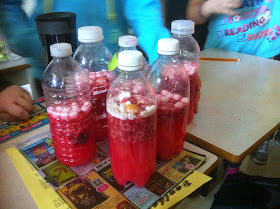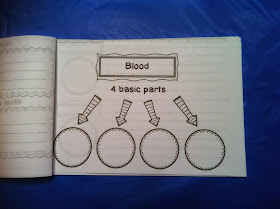Have you ever had to teach students about the different human body systems? It is no easy task because there is just so much vocabulary and new concepts to learn with each system. Hi, it is Jane here checking in again with a few tips that have worked for me when teaching this unit as part of my science program.
1. Videos, Videos, Videos
When teaching the different systems I think it is very important to involve every sense you can. I don't know about you but I am a very visual learner so watching a short video always helps me to better understand a topic. I have been lucky to have access to BrainPop and BrainPop Jr at my schools. I also really like the videos found on the KidsHealth website. I find showing a video can be a great way to introduce a body system or you can also show one at the end to consolidate student's learning.
 |
| KidsHealth Website |
 |
| BrainPop Website |
2. Experiments, Experiments, Experiments
I try to provide a hands on experiment for each body system that I teach. Sometimes when I am in the middle of an experiment with twenty five students, I begin to say to myself "What was I thinking?". Then I will hear a student say "This is the most fun I ever had in science!" and I will know all the prep time that went into preparing the lesson and a somewhat chaotic science class was well worth it.
My favourite experiment when teaching about the circulatory system is how to make blood. I know it may sound a bit gross but the students love putting it altogether. Teacher tip: Take it from me, do not leave it in your class for too many days and do not open the top! It may look cool but it doesn't smell too nice.
 |
| Model of Blood |
My favourite experiment when teaching about the respiratory system is to make a model lung. I make the model using only one balloon but students still get the idea about how we breathe. My students love making these and are always so excited to bring them home to show their parents how the the diaphragm works.
 |
| Model Lungs |
Teaching about the digestive system just wouldn't seem complete without having students squeeze some crackers and water together in a Ziploc bag to demonstrate how the stomach muscles in our stomach work. The students find it disgusting but they love it just the same.
3. Note takers, Note takers, Note takers
After all the videos, experiments, and reading about the various systems I had to come up with some way to help my students organize their learning. Thus the human body system note takers were born! I work with my students to help them complete the various organizers on each system. Below are some images from the Circulatory Note taker to give you an idea of how they work.

You can have a look at the various science note takers at my TPT store by clicking here. They have certainly helped my students by keeping them organized and learning about science in an engaging and fun way.








No comments:
Post a Comment
Note: Only a member of this blog may post a comment.